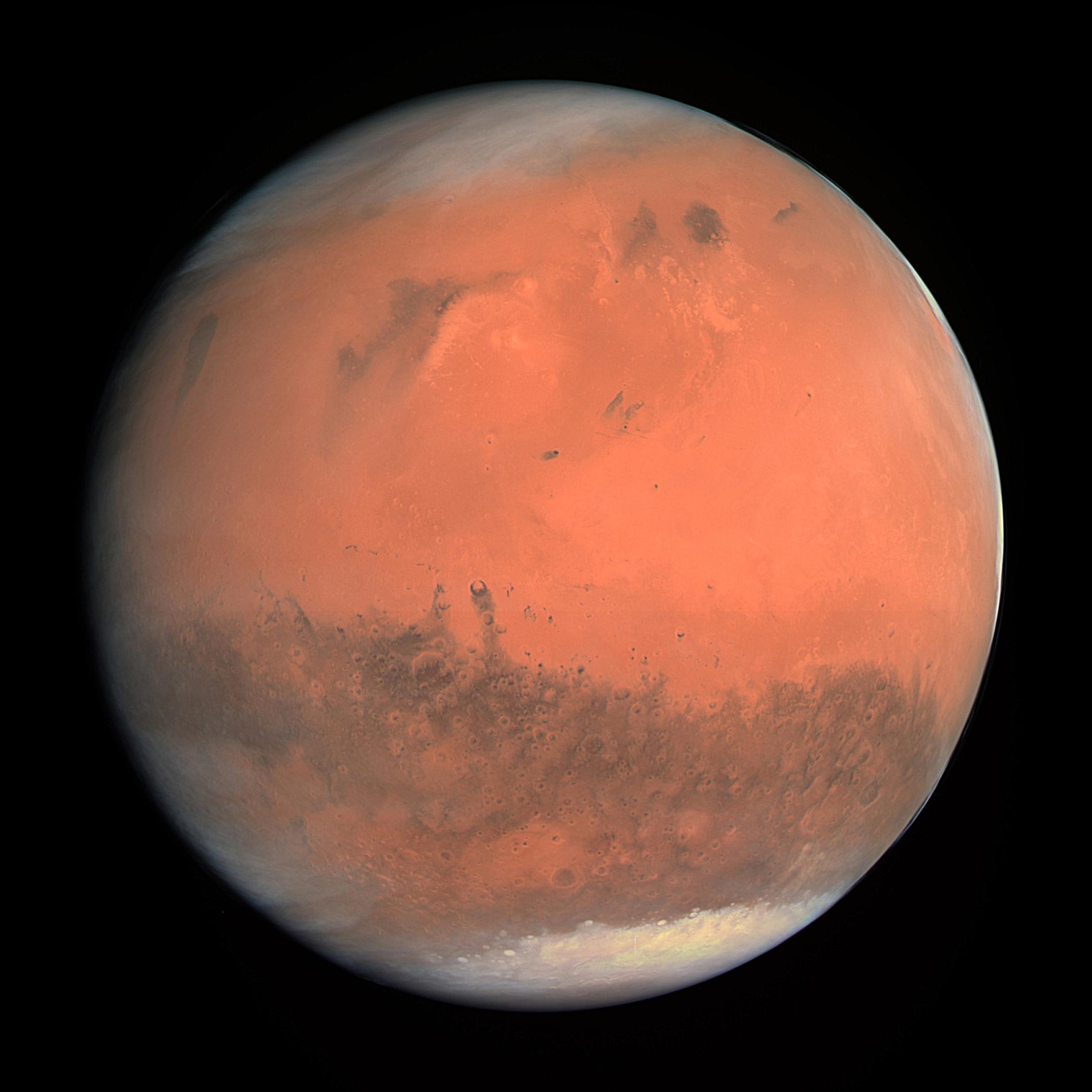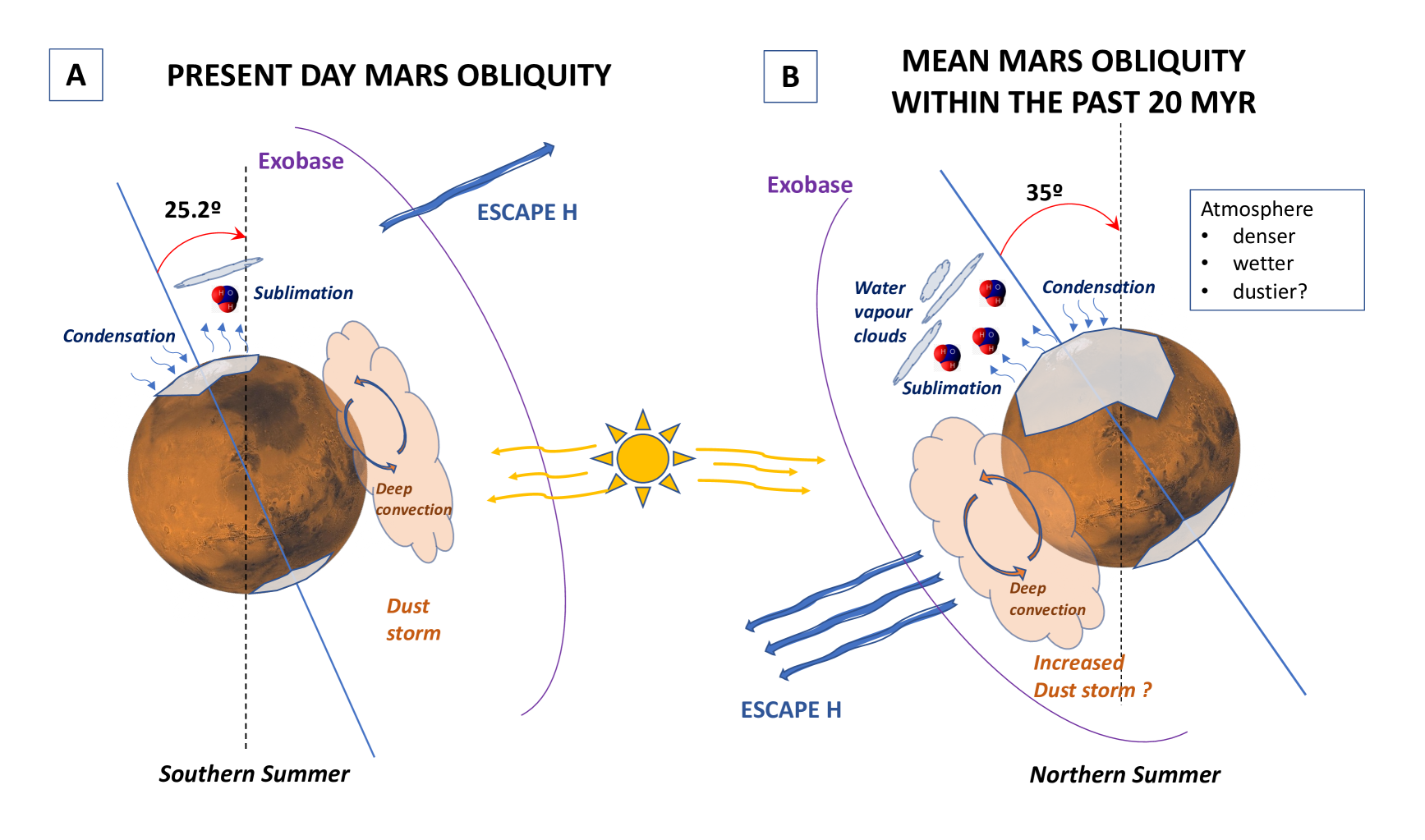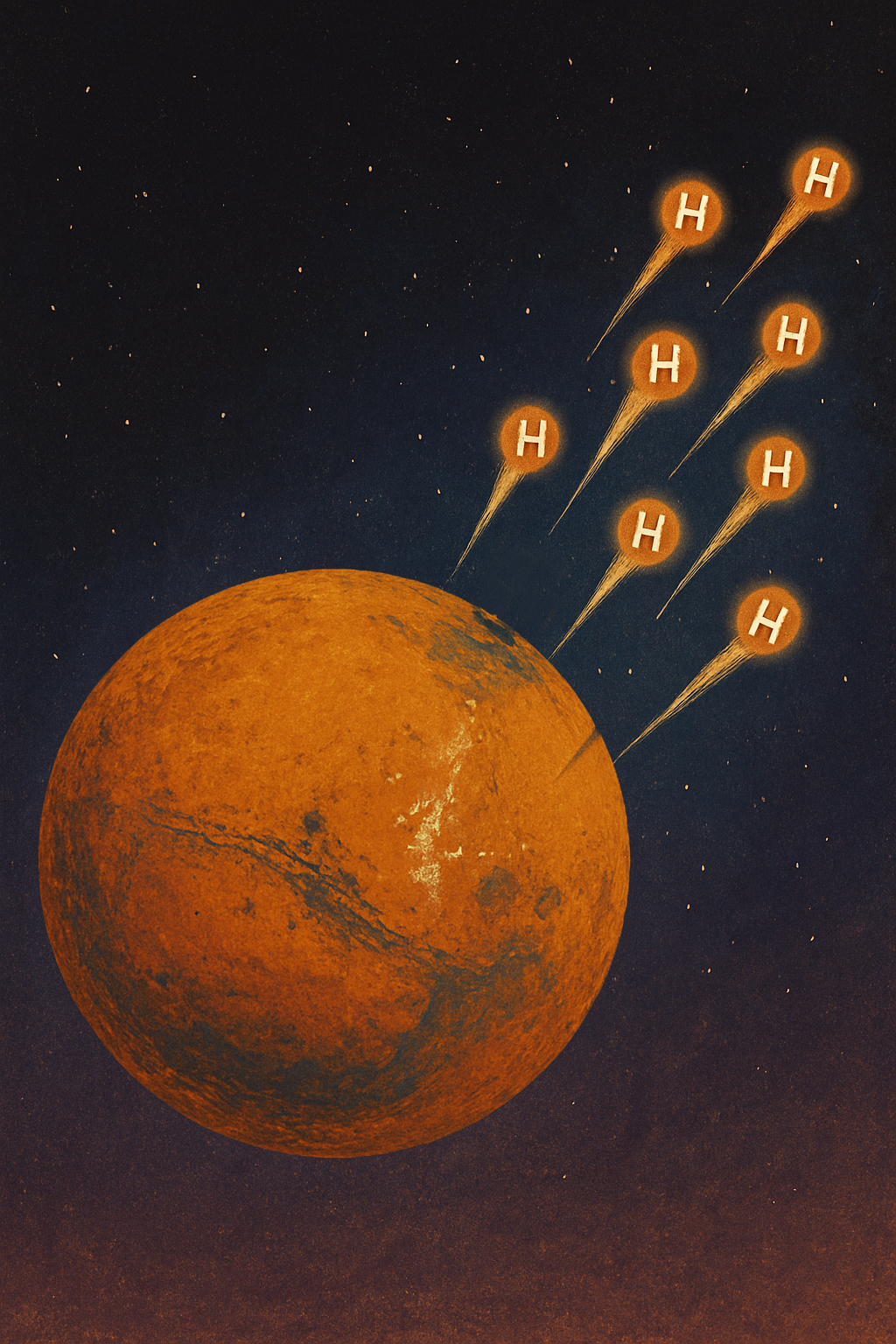New clues to understanding the loss of the water Mars hosted billions of years ago
The study, led by the Institute of Astrophysics of Andalusia (IAA-CSIC) and published in Nature Astronomy, analyzes the role of Mars’ axial tilt in the planet’s water loss
The scientific team has incorporated key improvements into the climate model used, allowing for a more accurate representation of current hydrogen escape—and therefore water loss—into space
Mars is now an extremely arid planet, with pressure and temperature conditions that prevent liquid water from existing on its surface. However, geological and mineralogical evidence points to the presence of large volumes of water in the distant past, in the form of rivers, lakes, and even oceans. Despite decades of research, one of the biggest mysteries in Mars’ history remains unsolved: what happened to all that water?

True-color image of Mars taken by the OSIRIS instrument aboard ESA's Rosetta spacecraft during its flyby of the planet in February 2007. The image was generated using OSIRIS's orange (red), green and blue filters. Credit: ESA & MPS for OSIRIS Team MPS/UPD/LAM/IAA/RSSD/INTA/UPM/DASP/IDA
A new study led by the Institute of Astrophysics of Andalusia (IAA-CSIC) has analyzed the role of obliquity—the tilt of the planet’s rotational axis—in the loss of hydrogen, and thus of water, from the Martian atmosphere over time.
“To understand the study, it’s important to know that Mars’ obliquity has varied significantly throughout its history,” says Gabriella Gilli, a researcher at the IAA-CSIC and co-lead author of the study. She adds: “The three-dimensional climate model we used suggests that, during periods of high obliquity, the escape rate may have been up to nearly twenty times higher than it is today.”
The study was recently published in the scientific journal Nature Astronomy.
Francisco González-Galindo, also a researcher at the IAA-CSIC and co-lead author, notes: “If we gathered all the water present on Mars between three and four billion years ago, we’d get a global ocean over 100 meters deep.”
WHERE DID MARS’ WATER GO?
Some of that water may still be present underground today, trapped as ice or bound within hydrated minerals. However, another portion has been lost to space through a process known as atmospheric escape, in which atoms and molecules gain enough energy to overcome the planet’s gravitational pull and escape into interplanetary space.
The current rate of hydrogen escape is not sufficient on its own to explain the loss of the vast amount of water that existed in the past.
Mars’ orbit experiences periodic variations that significantly affect its climate. One of the most important of these is the change in the tilt of its rotational axis, known as obliquity.
“Although Mars’ current obliquity is similar to Earth’s—about 25 degrees—over the last hundreds of millions of years it has varied widely, with an average close to 35 degrees,” explains Gilli (IAA-CSIC).
Although it is well known that these variations have a strong influence on Mars’ water cycle, until now their impact on water loss through atmospheric escape had not been explored.
The study investigated the relationship between Mars’ obliquity and water loss over time, revealing that during periods of high axial tilt, solar radiation at the poles increased. This intensified the water cycle and produced a warmer, more humid atmosphere.
Under those conditions, water vapor reached higher layers of the atmosphere, where it was more vulnerable to solar radiation that broke it down into hydrogen and oxygen atoms. Because hydrogen atoms are very light, they could more easily escape into space, contributing to the planet’s water loss.

Schematic showing the processes that have led to increased H loss over the past 20 million years (Myr). The rate of loss is not expected to have been constant over time, and may vary significantly during Martian history. Credits - Mars image: NASA/JPL/USGS | Figure: Gilli, G., González-Galindo, F., Chaufray, JY. et al. Increased hydrogen escape from Mars atmosphere during periods of high obliquity. Nat Astron (2025)
The research team estimates that hydrogen loss during high-obliquity periods could explain the disappearance of an amount of water equivalent to a global ocean about 80 meters deep. This figure aligns with the lower end of current estimates for the water Mars once hosted. “While that may seem modest compared to Earth, on Mars it represents a significant portion of its ancient water, making its impact highly relevant,” says Gabriella Gilli (IAA-CSIC).
SIMULATING MARS’ CLIMATIC PAST
The key tool used in this study, the Mars Planetary Climate Model (Mars-PCM), was originally developed by the Laboratoire de Météorologie Dynamique in Paris in collaboration with other international institutions. The Institute of Astrophysics of Andalusia (IAA-CSIC) has been actively involved in its development and optimization for more than two decades.
For this study, the IAA-CSIC team introduced major improvements to the Mars-PCM, including new chemical compounds and reactions. These additions made it possible, for the first time, to accurately reproduce hydrogen escape observations made by missions such as NASA’s MAVEN and ESA’s Mars Express.
The team also carried out simulations showing how changes in Mars’ axial tilt have influenced the escape of water into space.
“Our results suggest that hydrogen escape played a more important role in Mars’ desiccation process than previously thought. This is key to reconstructing how much water the planet has lost to space over its history,” says Francisco González-Galindo (IAA-CSIC).

Artist's rendering of the hydrogen leak on Mars. Credits: Image generated with Artificial Intelligence (ChatGPT, OpenAI)
ASTROBIOLOGICAL AND CLIMATIC IMPLICATIONS
The study also has astrobiological implications. Understanding how changes in Mars’ axial tilt intensified the water cycle and facilitated water loss helps refine the search for periods when the planet might have been habitable.
“Knowing when and how the right conditions existed—and when they disappeared—is essential to assess whether Mars could have hosted life at some point in its history,” emphasizes Gabriella Gilli (IAA-CSIC).
Additionally, the work highlights just how strongly orbital parameters can transform a planet’s climate. “While on Earth the variations are mild thanks to the stabilizing effect of the Moon, on Mars they have caused dramatic changes that affected its water, atmosphere, and ultimately, its ability to support life,” says Francisco González-Galindo (IAA-CSIC).
“This long-term view of planetary climate change also offers a valuable perspective on the fragility of the conditions that make habitability possible—and underscores the importance of protecting our own planet,” concludes Gilli (IAA-CSIC).
- 'Increased hydrogen escape from Mars atmosphere during periods of high obliquity'
- https://www.nature.com/articles/s41550-025-02561-3
- Gabriella Gilli - gilli@iaa.csic.es
- Francisco Gonzalez Galindo - ggalindo@iaa.csic.es
Instituto de Astrofísica de Andalucía (IAA-CSIC)
Unidad de Divulgación y Comunicación
Silbia López de Lacalle - sll[arroba]iaa.es - 958230532
http://www.iaa.es
http://www-divulgacion.iaa.es

